Adventure on Film: Could Holy Grail be the Funniest Film Ever?
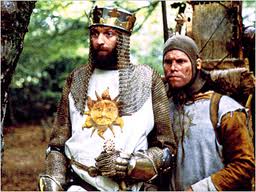 Just as an older generation recalls with perfect clarity where they were when they heard of Kennedy’s assassination, I know precisely where I first saw Monty Python and the Holy Grail (1975): perched on the floral-print sofa in my parent’s house, watching the film on a poor, weather-impacted PBS broadcast. I also remember falling right off that sub-par couch in paroxysms of laughter when the animator saved King Arthur’s band by conveniently suffering a heart attack.
Just as an older generation recalls with perfect clarity where they were when they heard of Kennedy’s assassination, I know precisely where I first saw Monty Python and the Holy Grail (1975): perched on the floral-print sofa in my parent’s house, watching the film on a poor, weather-impacted PBS broadcast. I also remember falling right off that sub-par couch in paroxysms of laughter when the animator saved King Arthur’s band by conveniently suffering a heart attack.
I’d never seen anything like it.
And you know what? I’ve never seen anything like it since –– except perhaps Brian’s rollercoaster romp aboard a purple-people-eater’s spaceship in another Python outing, Life of Brian. (That one I saw in a theater, with my church-going mother sitting next to me. She laughed her head off.)
What I didn’t know back when I fell of that couch, as I’m fairly sure I do now, is that comedy is little more than tragedy plus time.
No wonder, then, that in tackling the Grail tale, the Pythons struck a vein of comedic gold. Before the Pythons got hold of it, the epic tragedy of the Arthurian mythos had enjoyed over a thousand years of stewing, aging, and fermentation. Given a thirty-five millimeter camera, a link or two of chainmail, and a pair of coconut shells, how could they possibly miss?
They didn’t, of course; they fired off a cinematic arrow that worked fine in its day and has only grown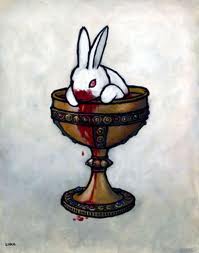 funnier. Monty Python and the Holy Grail not only stands up to repeated viewings, it now finds itself sparring with only a handful of other celluloid classics for the title of Funniest Film Ever Made.
funnier. Monty Python and the Holy Grail not only stands up to repeated viewings, it now finds itself sparring with only a handful of other celluloid classics for the title of Funniest Film Ever Made.
Oddly, what even its adherents rarely remark on is the fantastical provenance of Grail’s source material. Thanks to the unquestioned importance of Thomas Malory’s Morte d’Arthur in the literary canon, the Arthurian cycle in general gets a free pass when it comes time to consider its status as genre material. Malory found in these legends the stuff of epic romance; but make no mistake, all the tropes are here: wizardry, prophecy, flashing swords, clanking armor.
To Malory’s basic recipe, the movie-minded Pythons brought three key ingredients: unswerving commitment, merciless wit, and a flair for deconstruction.
Commitment –– or, as the Brits might say, bloody single-mindedness –– is the very wellspring of comedy. Forget about all that time plus tragedy stuff, which does nothing to explain the genius of John Cleese in the midst of his silly walks routine. Comedy stems, as Cleese knew better than anyone, from absolute commitment, the belief that whatever you’re pursuing, however stupid and unworthy, is absolutely all-important. Thus Graham Chapman’s King Arthur, who insists he is King of the Britons with maniacal constancy and regal certitude, even though practically nobody listens. Thus the fearsome Black Knight, who guards a forest path and informs King Arthur that “None shall pass.” The reason for the knight’s determination is unimportant; all that matters is that he sticks to his task –– and so he does, much to his limb-challenged detriment.
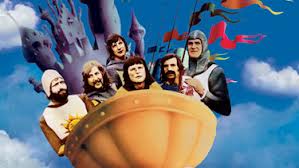 Commitment in Python’s Grail world is generally so complete that it obviates the need to ask questions or allow for any sort of (probably useful) self-examination. The peasants of ancient Britain look askance at Patsy’s stupid coconut-shell horse, but Patsy never does. Banging those shells together is what makes him go, period. Similarly, none of Arthur’s knights consider that the Knights Who Say “Nee” might not, in fact be dangerous; rumor says they are, so that’s it: they’re terrifying, full stop. And why must a single one of the Arthurian troop cross the Bridge of Death with its guardian’s silly color-questions? Surely they could just veer around. But no: the lemming-logic of commitment demands they face the enemy on the enemy’s (idiotic) terms.
Commitment in Python’s Grail world is generally so complete that it obviates the need to ask questions or allow for any sort of (probably useful) self-examination. The peasants of ancient Britain look askance at Patsy’s stupid coconut-shell horse, but Patsy never does. Banging those shells together is what makes him go, period. Similarly, none of Arthur’s knights consider that the Knights Who Say “Nee” might not, in fact be dangerous; rumor says they are, so that’s it: they’re terrifying, full stop. And why must a single one of the Arthurian troop cross the Bridge of Death with its guardian’s silly color-questions? Surely they could just veer around. But no: the lemming-logic of commitment demands they face the enemy on the enemy’s (idiotic) terms.
All the better for we viewers, of course. Had the Pythons settled for real logic instead of logical upshots, Grail would have been nothing more than an ABC After-School Special.
Worse, it would cease to be critic-proof; which, at present, it basically is. What can possibly be levied against a film in which ballistae hurl cows instead of rocks?
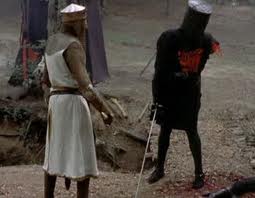 Wit-wise, it’s easy to forget that the goofball Pythons were graduates of Cambridge University, and received a rigorous, old-fashioned British education. When their academic coursework failed to fully ignite their imaginations, they fell back on an equally critical field of study: the comedic legacies of Spike Milligan, Flanders & Swann, and Beyond the Fringe. With all these as a collective alma mater, the Pythons (newly armed with American Terry Gilliam) chose to skewer the very educational system that created them. In order to do this, they had to keep tight hold of the exact sort of material that most comedians jettison as being too intellectual or requiring too much prior knowledge.
Wit-wise, it’s easy to forget that the goofball Pythons were graduates of Cambridge University, and received a rigorous, old-fashioned British education. When their academic coursework failed to fully ignite their imaginations, they fell back on an equally critical field of study: the comedic legacies of Spike Milligan, Flanders & Swann, and Beyond the Fringe. With all these as a collective alma mater, the Pythons (newly armed with American Terry Gilliam) chose to skewer the very educational system that created them. In order to do this, they had to keep tight hold of the exact sort of material that most comedians jettison as being too intellectual or requiring too much prior knowledge.
The Pythons, then, never talked down to their audience. Instead, they forced the audience to rise up. Sure, they created the “confuse-a-cat” sketch, and the eternally stupid fish slapping dance, but alongside the buffoonery, you get Holy Grail’s Ancient Britons arguing with their “rightful” monarch, Arthur, about every possible form of governance, including those yet to be invented.
This unexpected willingness to not only accept, but to promote, sharp-mindedness is on full display back at the Bridge of Death. King Arthur bests the bridge’s guardian only by demanding additional details about the man’s impertinent, smug questions. One can almost hear the Pythons rising up in a Trinity College lecture hall and insisting that the don in charge explain, to their satisfaction, why a Parliamentary system would in all cases be better than an enlightened monarchy. No syllogisms, please. No tautologies. Just spit it out, man. And if you don’t, off you go to the Bridge of Death.
Deconstruction, the final ingredient of the Python’s secret formula, might usefully be viewed as a byproduct of western humanity’s shared dismay at the incredible destruction caused by World War I. Modernism, most called it, and in the arts, modernism turned reality on its head. Without it, we wouldn’t have Cubism, or Ezra Pound, or John Cage. Twentieth Century technology, hand in hand with Twentieth Century post-bomb nerves, inverted or estranged everything it could get its hands on.
 One day, we’ve got the Andrews Sisters and the Fleetwoods, and the next we’ve veered into strange, tenebrous corners populated by the Beatles, the Fugs, and Frank Zappa. In the realm of the written, authors took fictional structures to pieces, filling the shelves with the dense, allusion-ridden poetry of Eliot and (later) the endless loops of Vonnegut and Heller, or the dissipated, darkly hilarious stories of Donald Barthelme (who really ought to be re-evaluated as a fantasist).
One day, we’ve got the Andrews Sisters and the Fleetwoods, and the next we’ve veered into strange, tenebrous corners populated by the Beatles, the Fugs, and Frank Zappa. In the realm of the written, authors took fictional structures to pieces, filling the shelves with the dense, allusion-ridden poetry of Eliot and (later) the endless loops of Vonnegut and Heller, or the dissipated, darkly hilarious stories of Donald Barthelme (who really ought to be re-evaluated as a fantasist).
True, there’s nothing entirely new under the sun. Deconstruction has existed in tandem with construction for as long as the stars have twinkle-twinkled in their places. Look at what Mark Twain did to Camelot in A Connecticut Yankee In King Arthur’s Court. Or consider the Marx Brothers, who cobbled together Vaudeville with traditional romantic comedies on the way to Duck Soup and Night At the Opera.
The anarchy begun by Harpo Marx (flirtation by means of one raised leg and one beeped horn), found its apotheosis in the Pythons, who sometimes quite literally ripped up every convention in sight. In their television show, Monty Python’s Flying Circus, the Pythons spat first in the face of comedy’s assumption that any given sketch had to find a logical endpoint, and then assaulted television itself by inserting the credits, both opening and closing, pretty much wherever they pleased. (Grail’s credits are famously interrupted by Norse moose.)
In the world of the Flying Circus, formally dressed bankers hold meetings in rivers, as if that could and should be normal; penguins explode not because this makes sense, but because it doesn’t; somber theatrical re-enactments are reduced to cross-dressing men whacking each other with purses on muddy, kelp-infested beaches.
All the Pythons lacked was a greater ambition, a solid story arc worthy of their particular version of “Ready, aim, fire.” In King Arthur, they found what they needed. What that panoramic but clear arc provided was necessary glue, a structure solid enough to give proper shape and dramatic weight to the otherwise untethered shenanigans of Python-style comedy. The Round Table served up conventionality at its most formal, thus inviting (as sacred cows invite meat grinders) the total violation of those same conventions. Forget about Camelot as a locus of higher ideals and noble aspirations; with the Pythons at the helm, the word “Camelot” serves mostly as a rhyme scheme for “pram a lot.”
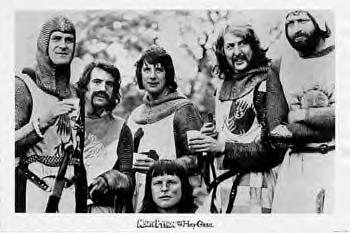 Those who find comedic value in Monty Python and the Holy Grail, but who do not self-identify as fans of fantasy adventure might be inclined to write off the painted shields and towering castles as mere window dressing. Wrong. Far from being incidental, the knightly particulars of Grail serve not only as essential source material, but as constant comedic ammunition. The Pythons approached each historical element as an opportunity to introduce overt disjunctions: Lancelot arrested by London bobbies and squad cars; grenades in the hands of sword-wielding knights; a cult devoted not to plants in general, but to flora’s contemporary and domesticated offspring, shrubbery.
Those who find comedic value in Monty Python and the Holy Grail, but who do not self-identify as fans of fantasy adventure might be inclined to write off the painted shields and towering castles as mere window dressing. Wrong. Far from being incidental, the knightly particulars of Grail serve not only as essential source material, but as constant comedic ammunition. The Pythons approached each historical element as an opportunity to introduce overt disjunctions: Lancelot arrested by London bobbies and squad cars; grenades in the hands of sword-wielding knights; a cult devoted not to plants in general, but to flora’s contemporary and domesticated offspring, shrubbery.
Spamalot, Eric Idle’s Broadway re-write of Holy Grail, adds social issues to the costume drama by way of Lancelot, who, homicidal maniac though he surely is, turns out to be gay. (“No one would ever know / that this outrageous pro / bats for the other team!”)
To belabor this point slightly further, it is not especially funny to have a Frenchman insult an Englishman, no matter how clever the jibes. But when that Frenchman becomes a French knight, and he’s thumbing his nose not just at some random Joe Schmo Englishman, but at King Arthur –– at the entire Arthurian oeuvre –– that’s funny.
Thus, my revised postulation: comedy is tragedy plus time plus full-bore commitment, but comedy is also context, and in this case, the context is unmistakably grounded in the fantastic.
In strictly cinematic terms, Grail is a rocky road. Co-directors Gilliam and Jones fell into the shaky, hand-held camera style of Grail not as a cinematic statement, but because they didn’t have the experience, time, or budget to set up more complex tracking shots. The Blair Witch Project looks the way it does because it was a conscious choice; Grail looks the way it does because this was the best they could come up with.
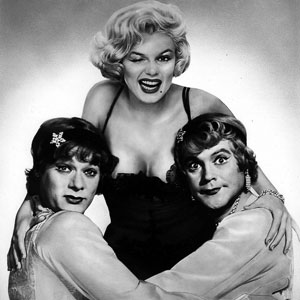
Luckily, the muddy Middle Ages subject matter and the Pythons’ generally disjointed style come to the film’s rescue time and again. For once, crappy camerawork reinforces the story. They couldn’t have planned it any better.
And nearly forty years on, the critics seem to agree. At Slant, the verdict is “brilliant.” Film Threat calls it “the silliest movie ever made.” All Movie gives it five stars. The New York Times, ever cautious, describes it as “A marvelously particular kind of lunatic endeavor,” while Richard Schickel, writing in Time, claims that “Grail is as funny as a movie can get, but it is also a tough-minded picture –– as outraged about the human propensity for violence as it is outrageous in its attack on that propensity.”
So where does Holy Grail fit in the comedic pantheon, a critical list that most cinephiles would agree includes Some Like It Hot, Annie Hall, Tootsie, The Gold Rush, Dr. Strangelove, The Graduate, Airplane and Bringing Up Baby? The final decision is subjective, of course: but there’s no question that Grail, even amidst such illustrious company, is a mighty contender.
Several editions now grace the shelves, all of which will, I’m sure, eventually be available as downloads. Compared to the faded, scratched prints I remember from yesteryear, all of them look pretty good. The colors are more vivid, the sound crisp (enough), and of course there are interviews and extras aplenty.
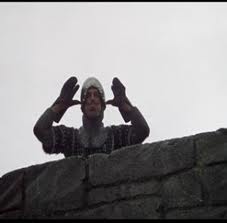 But none of that really matters.
But none of that really matters.
What matters in this particular quest for the Grail is that before you settle in to watch, you find a nice, comfy couch.
That way you’ll be ready, when the moment comes, to fall right off.
But try not to hit your head.
Although that would, very likely, be funny…in time.
Read Mark Rigney’s complete short story “The Trade” — which Tangent Online calls ‘Marvelous‘ — here.
A guy I knew years ago used to work in a theater that did repertory stuff. He told me that one time they did a double feature of Monty Python and the Holy Grail and Excalibur. And that they _very_ quickly discovered that you had to show Excalibur first …
Joe – I wonder what it would be like to see them back-to-back with Excalibur second…probably unfortunately hilarious…
That’s exactly why they had to switch them — people were laughing all the way through Excalibur.
[…] Adventure on Film: Could Holy Grail be the Funniest Film Ever? […]